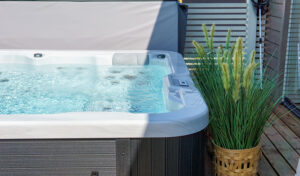It’s not uncommon to see swim spas in homeowners associations. Residents see it as a cheaper alternative to backyard pools, though not all communities might permit it. Homeowners should make sure to review their association’s governing documents before installing a swim spa. Similarly, HOA boards should approach the topic with caution to avoid potential liability.
What Are Swim Spas in Homeowners Associations?
To homeowners, having a swimming pool in their backyard means having the freedom to escape the summer heat any time they want. It is not only a way to beat the heat but also a sign of simple luxury. But pools can be cumbersome to install, especially in-ground pools. As a result, a lot of homeowners opt to invest in a swim spa instead.
So, what is a swim spa?
A swim spa, as its name suggests, is a hybrid of a pool and a spa, combining their distinctive features. It is usually heated and offers hydromassage while being big enough for swimming. It is larger than a jacuzzi but typically smaller than a standard pool.
Despite what they are used for, it is important to understand that swim spas are not pools. In terms of design and components, a swim spa is more similar to a jacuzzi. This is because all of the components of swim spas are self-contained. That means no equipment, plumbing, or parts are located outside of the cabinet.
Many homeowners prefer swim spas over pools because they are much easier to install. They already come fully built and ready to use. In comparison, pools require a fair bit of excavation, construction, and plumbing work. Even above-ground pools, which don’t require excavation, are difficult to install.
Swim spas, though, are not as widely available or commonplace. As such, most HOAs don’t have rules that regulate them. Still, that will not stop homeowners from procuring swim spas and placing them squarely in the middle of their yards or decks.
Rules on Swim Spas in Homeowners Associations
 Homeowners associations are known for their many rules and regulations. From how often homeowners need to mow their lawns to where they can park their vehicles, HOAs have rules for almost everything.
Homeowners associations are known for their many rules and regulations. From how often homeowners need to mow their lawns to where they can park their vehicles, HOAs have rules for almost everything.
While these rules may seem suffocating, they do serve a purpose. Rules help maintain the character and aesthetic of the community. By maintaining the community’s appeal, these rules also help preserve property values.
Most HOA communities have a particular set of rules governing architectural changes. These are called architectural guidelines. While the exact guidelines can differ from one HOA to another, they usually dictate what owners can and can’t do to their property. For instance, an HOA might prohibit owners from painting their homes a certain color or constructing a balcony without approval.
Basically, any modifications, alterations, or additions are subject to the HOA’s rules. In many communities, owners must go through an application and approval process before they can make any changes.
The same rules can also apply to recreational structures, such as basketball hoops and swimming pools. But, the rules regarding swimming pools may not apply to swim spas because they are different things. The only exception is if the HOA’s rules specifically mention swim spas or describe them. Swim spas don’t fit the description of above-ground pools either because the former have self-contained components while the latter do not.
With this in mind, an HOA that wishes to restrict swim spas should craft rules that specifically govern them. These rules include but are not necessarily limited to the following:
1. Compliance With Local Regulations
First of all, all swim spas should comply with state and local regulations. More often than not, homeowners will need to look up the setback rule in their local area. A setback rule is the minimum distance that a structure — in this case, a swim spa — must be placed behind the property line.
Another local regulation an owner must check is lot coverage. This refers to the percentage of the property that is occupied by a structure. Whether or not swim spas fall under the definition of a structure will depend on the local municipality or zoning board.
Lastly, in some places, owners must ensure that their swim spa is UL-listed. A UL listing proves that the swim spa is safe to use. An HOA that permits swim spas should, at the very least, make it a requirement that owners comply with local regulations.
2. Approval to Install
Swim spas should also fall under an HOA’s architectural guidelines. This includes requiring homeowners to seek approval before installation. The approval process can vary depending on the association. But, it usually involves filling out an application form and submitting supporting documents, including design plans, blueprints, and contractor/supplier information.
3. Conform With the HOA’s Aesthetics
Although part of the approval process involves checking whether or not a swim spa’s design matches the HOA’s aesthetic, it is still important to emphasize this rule. Homeowners should look for a swim spa supplier that offers designs that conform with the overall personality of the community. This requirement helps maintain the uniform appearance of the association.
Amending Your Governing Documents
If your governing documents don’t currently cover swim spas, it is best to address them. While the HOA board can pass resolutions to create new rules, it is generally better (and more effective) to work these rules into the CC&Rs. Of course, that would mean amending the governing documents.
Depending on state laws and your CC&Rs, amending your governing documents typically requires the membership’s vote. For instance, the North Carolina Planned Community Act requires an affirmative vote from at least 67% of the membership or any larger majority specified in the declaration.
An HOA board cannot arbitrarily prohibit or restrict swim spas without the association’s rules to back it up. Thus, the board should ensure the HOA’s rules cover swim spas before taking any enforcement action. Otherwise, the board is exposing itself and the HOA to potential liability.
Regulating Swim Spas in Homeowners Associations
 Swim spas are a great alternative to swimming pools, which is why they have become quite popular lately. Boards, though, should make sure to cover all of their bases and review their governing documents as soon as possible. This way, they can regulate swim spas and ensure that they conform to the association’s architectural standards.
Swim spas are a great alternative to swimming pools, which is why they have become quite popular lately. Boards, though, should make sure to cover all of their bases and review their governing documents as soon as possible. This way, they can regulate swim spas and ensure that they conform to the association’s architectural standards.
Cedar Management Group provides professional HOA management services to community associations. Call us today at (877) 252-3327 or contact us online to get a free proposal!
RELATED ARTICLES:
- Is HOA Pool Fencing A Legal Requirement?
- HOA Backyard Rules: What Can And Can’t Homeowners Do
- Is An HOA Responsible For Water Damage?






